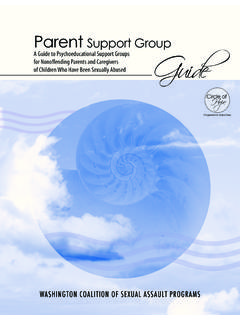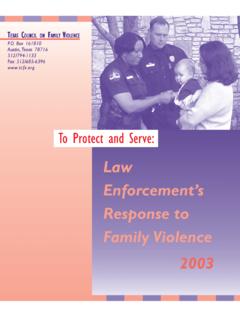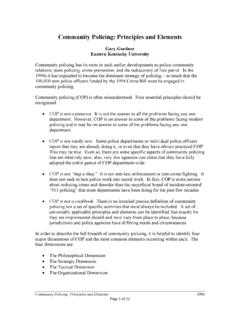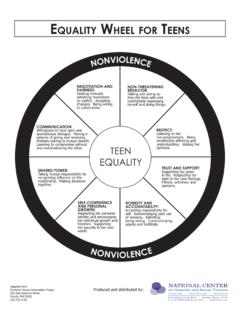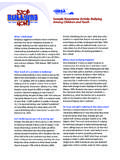Transcription of Facts for Teens: Bullying - National Center on …
1 Toll-Free:1-866-SAFEYOUTH (1-866-723-3968)TTY:1-800-243-7012 FAX:301-562-1001 Facts for teens : BullyingIntroductionIn the United States, Bullying among children and teenagers has often been dismissed as a normal part of growing up. Little attention has been paid to the devastating effects of Bullying , or to the connection between Bullying and other forms of violence. In recent years, however, students and adults around the country have begun to make a commitment to stop Bullying in their schools and is Bullying ? Bullying includes a wide variety of behaviors, but all involve a person or a group repeatedly trying to harm someone who is weaker or more vulnerable.
2 It can involve direct attacks (such as hitting, threatening or intimidating, maliciously teasing and taunting, name-calling, making sexual remarks, and stealing or damaging belongings) or more subtle, indirect attacks (such as spreading rumors or encouraging others to reject or exclude someone). How common is Bullying ? Almost 30 percent of teens in the United States (or over million) are estimated to be involved in Bullying as either a bully, a target of Bullying , or both. In a recent National survey of students in grades 6 to 10, 13 percent reported Bullying others, 11 percent reported being the target of bullies, and another 6 percent said they bullied others and were bullied available data suggest that Bullying is much more common among younger teens than older teens .
3 As teens grow older, they are less likely to bully others and to be the targets of occurs more frequently among boys than girls. Teenage boys are much more likely to bully others and to be the targets of bullies. While both boys and girls say others bully them by making fun of the way they look or talk, boys are more likely to report being hit, slapped, or pushed. Teenage girls are more often the targets of rumors and sexual While teenage boys target both boys and girls, teenage girls most often bully other girls, using more subtle and indirect forms of aggression than boys. For example, instead of physically harming others, they are more likely to spread gossip or encourage others to reject or exclude another does Bullying affect teens who are the targets of bullies?
4 Bullying can lead teenagers to feel tense, anxious, and afraid. It can affect their concentration in school, and can lead them to avoid school in some cases. If Bullying continues for some time, it can begin to affect teens ' self-esteem and feelings of self-worth. It also can increase their social isolation, Box 6003 Rockville, MD for teens : Bullying , National Youth Violence Prevention Resource Center , :1-866-SAFEYOUTH (1-866-723-3968)TTY:1-800-243-7012 FAX:301-562-1001leading them to become withdrawn and depressed, anxious and insecure. In extreme cases, Bullying can be devastating for teens , with long-term consequences.
5 Some teens feel compelled to take drastic measures, such as carrying weapons for protection or seeking violent revenge. Others, in desperation, even consider ,6,7 Researchers have found that years later, long after the Bullying has stopped, adults who were bullied as teens have higher levels of depression and poorer self-esteem than can also affect those teens who witness the Bullying . In one study of junior high and high school students, over 88 percent said they had witnessed Bullying in their who witness Bullying can feel guilty or helpless for not standing up to a bully on behalf of a classmate or friend, or for not reporting the incident to someone who could help.
6 They may experience even greater guilt if they are drawn into Bullying by pressure from their peers. Some teens deal with these feelings of guilt by blaming the victim and deciding that he or she deserved the abuse. teens sometimes also feel compelled to end a friendship or avoid being seen with the bullied teen to avoid losing status or being targeted ,11 Which teens are most likely to become bullies? While many people believe bullies act tough in order to hide feelings of insecurity and self- loathing,in fact , bullies tend to be confident, with high ,13 They are generally physically aggressive, with pro- violence attitudes, and are typically hot-tempered, easily angered, and impulsive, with a low tolerance for frustration.
7 Bullies have a strong need to dominate others and usually have little empathy for their targets. Male bullies are often physically bigger and stronger than their Bullies tend to get in trouble more often, and to dislike and do more poorly in school than teens who do not bully others. They are also more likely to fight, drink, and smoke than their who come from homes where parents provide little emotional support for their children , fail to monitor their activities, or have little involvement in their lives, are at greater risk for engaging in Bullying behavior. Parents' discipline styles are also related to Bullying behavior: an extremely permissive or excessively harsh approach to discipline can increase the risk of teenage , bullies appear to have little difficulty in making friends.
8 Their friends typically share their pro-violence attitudes and problem behaviors (such as drinking and smoking) and may be involved in Bullying as These friends are often followers who do not initiate Bullying , but participate in mentioned above, some teenagers not only bully others but are also the targets of bullies themselves. Like other bullies, they tend to do poorly in school and engage in a number of problem behaviors. They also tend to be socially isolated, with few friends and poor relationships with their are the long-term consequences of Bullying behavior? Bullying is often a warning sign that children and teens are heading for trouble and are at risk for serious violence.
9 teens (particularly boys) who bully are more likely to engage in other Facts for teens : Bullying , National Youth Violence Prevention Resource Center , :1-866-SAFEYOUTH (1-866-723-3968)TTY:1-800-243-7012 FAX:301-562-1001antisocial/delinquent behavior ( , vandalism, shoplifting, truancy, and drug use) into adulthood. They are four times more likely than nonbullies to be convicted of crimes by age 24, with 60 percent of bullies having at least one criminal can schools do to stop Bullying ?Effective programs have been developed to reduce Bullying in schools. Research has found that Bullying is most likely to occur in schools where there is a lack of adult supervision during breaks, where teachers and students are indifferent to or accept Bullying behavior, and where rules against Bullying are not consistently approaches that simply crack down on individual bullies are seldom effective, when there is a school- wide commitment to end Bullying , it can be reduced by up to 50 percent.
10 One effective approach focuses on changing school and classroom climates by: raising awareness about Bullying , increasing teacher and parent involvement and supervision, forming clear rules and strong social norms against Bullying , and providing support and protection for all students. This approach involves teachers, principals, students, and everyone associated with the school, including janitors, cafeteria workers, and crossing guards. Adults become aware of the extent of Bullying at the school, and they involve themselves in changing the situation, rather than looking the other way. Students pledge not to bully other students, to help students who are bullied, and to make a point to include students who are left You Can DoIf You Are Being to your parents or an adult you can trust, such as a teacher, school counselor, or principal.
